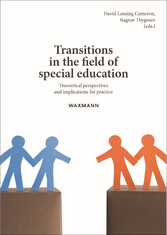Suchen und Finden
Service
Mehr zum Inhalt

Transitions in the field of special education - Theoretical perspectives and implications for practice
David Lansing Cameron & Ragnar Thygesen, University of Agder
Approaching the problem of transition in special education (p. 7-8)
The purpose of this book is to explore the phenomenon of transition as it relates to special education. On the one hand, the authors investigate transitions in the field of special education as a whole, with emphasis on historical developments, cultural contexts, and with respect to diverse guiding theories. On the other hand, we examine the process of transition in a wide range of areas, with an emphasis on the implications that transitions are likely to have for the provision of specialized support and individuals with special needs (e.g., from school to work, preschool to school, across teaching arrangements and so on). One can think of these two concerns rather simply as: (a) Special education in transition, and (b) Transitions in special education. Accordingly, the book is divided into two parts under these two headings. Given the nature of these two objectives, we will be dealing with the matter of Special education in transition first. The reason for this is simple. In order to understand when, why, and how special education can be of benefit, we must first reach some conclusions about the dynamic nature of the field as a profession, discipline, and practice. In short, we are required to throw ourselves into the debate about how special education is or perhaps “should be” defined. Not surprisingly, this discussion has been categorized as a “normative minefield” (Bachmann & Haug, 2006). In the second part of the book, Transitions in special education, the authors look first and foremost at how a better understanding of the phenomenon of transition under different conditions can be used to support individuals with special needs and their families. The context for this discussion is largely that of the Nordic countries in which the majority of the contributing authors work: Norway, Sweden, Denmark and Finland. However, the topics and approaches presented in the various chapters reflect international trends and dilemmas that are likely to be of relevance for a broad international audience.
We suspect that for many readers the book will present a new understanding of what special education and the concept of transition entail. We argue that in its current state, special education has reached far beyond a definition that is dependent upon a manner or system of service provision (e.g., special teaching approaches, differentiated content) or simply a context in which children who are struggling to meet the learning objectives of school are educated (e.g., special class, special school). Although in the view of the editors this has always been the case, it is only in recent years that this rather complex understanding of the field seems to have gained acceptance among educational professionals. From an historical perspective, changing attitudes and understandings of special education must also be seen in light of other closely related, often intertwined traditions, theories, beliefs, and approaches in the educational sciences as a whole. For example, in recent years we have seen the expansion and establishment of a field that has come to be known as “inclusive education,” which has come to mean much more than the physical placement of children with special needs in general education settings. By turning our focus towards ‘special’ rather than ‘inclusive’ education, this book may strike some readers as a rejection of the ideals of inclusion. This is by no means our intention. However, it seems that the concept of ‘inclusive education’ has come to encompass a great many, often diffuse set of ideas, while at the same time having a rather dilemmatic construction that is particularly difficult to apply in practice. Special education, on the other hand, has traditionally held a rather narrow focus and, although being comparatively straightforward in application, has often been characterized as not being particularly useful or effective. Indeed, efforts to empirically demonstrate the (in)effectiveness of special education as a legally founded, system-wide service seem to ebb and flow like the tide, occasionally causing headlines, yet rarely having major consequences for provision.
How to define transition in special education terms?
In the purest sense of the word, transition simply refers to a basic movement from one state of being to another. This may be a change in time (young to old, past to present), composition (simple to complex, individual to group), location (school to work), understanding or skill (novice to expert) and so on. In the literature, there are a variety of discourses on transition. Dunlop and Fabian (2002) define transition as, “the process of change that is experienced when children and their families move from one setting to another” (p. 3). Bergstrøm and Voll (2002) point out that it is necessary to distinguish between two different types of transitions: those that are dramatic and those that are commonplace. Dramatic transitions are comprehensive and involve great experiences, expectations and demands of competence and adjustment. Commonplace transitions are part of one’s daily routine, like going to and from school. In contrast, the transition from daycare to compulsory school, for example, has the potential to affect a child’s emotional well-being and long-term social development and can therefore be considered a “dramatic” transition (Dunlop & Fabian, 2002).
Alle Preise verstehen sich inklusive der gesetzlichen MwSt.








